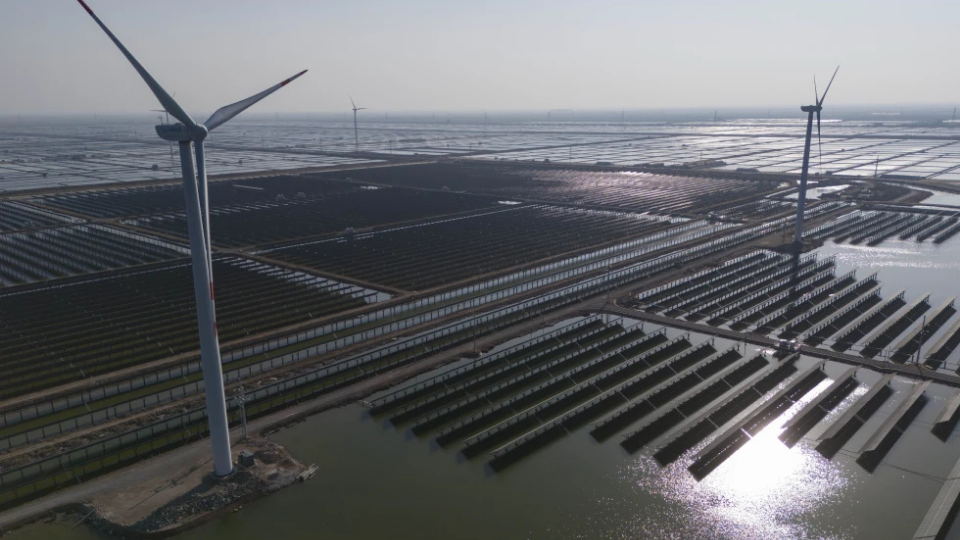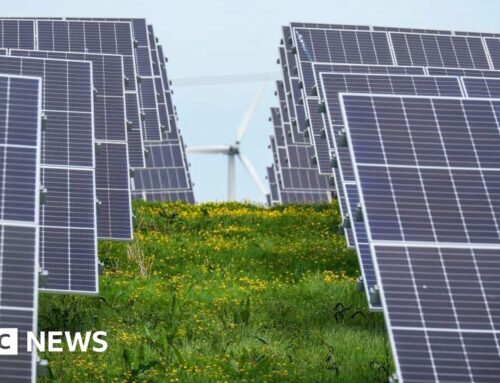China zeroes in and leads on renewable energy boom
October 2, 2025

Wind turbines dot the coastline along a giant solar farm near Weifang in eastern China’s Shandong province on March 22, 2024. |AP/Ng Han Guan
The energy transition is no longer about if, but about how. Climate targets cannot be postponed. Over the past two decades, China has deliberately concentrated its industrial might on renewable energy, setting global standards in solar, wind, batteries, and electric mobility. For Europe, the challenge is clear: how to shape its own path without falling into dangerous dependencies?
In an interview with Berliner Zeitung, China energy expert Belinda Schäpe of the Centre for Research on Energy and Clean Air (CREA) examines China’s unprecedented renewable energy boom, the shortcomings of European industrial policy, and the mounting risks of global supply chains. Schäpe argues that recycling and innovation will be strategic keys—and warns that Europe will only meet its climate goals if it develops a coherent geopolitical strategy.
Nuclear power in China’s mix
Schäpe reminds us that China is not only a nuclear power in the military sense but also continues to build civilian reactors. With around 60 gigawatts of capacity, the country ranks third globally, behind the United States and France. Each year in the past three years, more than ten new projects have been approved. This may sound substantial to German ears, she says, but when compared with the rest of China’s power system, it is tiny. China already has some 1,600 gigawatts of wind and solar capacity—roughly 25 times its nuclear output—and that sector is growing explosively.
“This year alone,” Schäpe notes, “China will add nine times more solar and wind power than it has in total nuclear capacity. Nuclear will likely remain part of the mix long-term, but at a relatively modest share of about ten percent.”
Small Modular Reactors (SMRs), meanwhile, remain controversial. Critics view them as too expensive, too insecure, and hardly new; the U.S. experimented with them as far back as the 1950s. Research is underway in China, Schäpe says, but it is unlikely SMRs will play a decisive role in decarbonization, not least because their small size makes them harder to secure. Nuclear fusion, she adds, remains highly speculative: “For fifty years it has always been promised as being fifteen years away.” Even in China, information about progress is scarce. “If it ever becomes commercially viable, it could be transformative,” Schäpe concedes, “but we simply do not have the time. The climate crisis won’t wait. What matters are the technologies we have today—and that means above all solar power, made affordable on a massive scale through Chinese mass production.”
How China became a leader
China’s green ascendancy did not happen overnight. As early as the 1990s and 2000s, the government declared renewable technologies a strategic priority, giving companies long-term planning certainty. When Xi Jinping announced climate goals in 2020, it was already clear that demand for green technology would surge.
The model has been consistent: Beijing sets direction, provinces compete to host leading firms, and companies engage in price and innovation battles. This dynamic has driven solar panels and batteries to become ever cheaper and more powerful. The story is the same with electric vehicles. Already in the early 2000s, so-called “New Energy Vehicles”—from EVs to hydrogen and hybrid models—were elevated to a national priority. By 2023, China was selling more electric cars than the rest of the world combined.
Europe at a crossroads
Does this mean Europe has lost the race? Not necessarily, Schäpe argues. The continent still has formidable assets: world-class universities, strong research centers, and competitive industries in areas such as wind power, heat pumps, and energy efficiency. Moreover, much of the value creation in renewables lies not just in manufacturing but in downstream stages such as installation, integration, and service—areas where European firms have real opportunities.
But Europe’s credibility is at stake. Clear, consistent industrial policy is needed. Schäpe stresses that mere funding is not enough: “If we keep putting our climate targets back up for debate—like the recent wavering over the planned 2035 combustion engine phaseout—we sow deep uncertainty in industry.” By contrast, China has pursued a consistent, uncompromising push toward electric mobility and continues to expand its markets. “If we tell ourselves that combustion engines still hold future markets, we are walking straight into a dead end,” she warns.
Real industrial policy, Schäpe insists, means setting long-term guardrails, directing innovation, and—critically—listening to businesses themselves. Start-ups and entrepreneurs must be able to point to obstacles in financing, bureaucracy, or competition, and policymakers must respond. Only with such a feedback loop can Europe build a strategy robust enough to compete with China and the United States.
The supply chain dilemma
One of the most pressing issues is Europe’s reliance on China for critical technologies. Around 90 percent of the world’s key inputs for renewables now carry a Chinese footprint.
Schäpe distinguishes this from dependence on Russian gas. Gas was existential, she notes—you could not simply switch it off. Renewables are different: once solar and wind installations are built, they keep producing, regardless of trade disruptions. Still, new expansion could be jeopardized if supply chains are cut. The lesson is clear: “We must avoid new dependencies. That means diversified supply chains, storage capacity, and reliable trade agreements.”
Particularly with critical minerals—lithium, germanium, neodymium—China has entrenched dominance in processing, even if the raw materials often come from elsewhere. Europe urgently needs its own processing capacity. That is directly tied to circular economy strategies. For decades, Europe shipped its waste to China, where robust recycling industries emerged, now tightly linked to green technology supply chains. Europe lacks such structures—and must build them. “If we can reuse resources, we will also dramatically improve supply security,” Schäpe explains.
The European Union, she says, should therefore treat recycling as a strategic priority alongside new investment. Commission President Ursula von der Leyen recently underscored this in her “State of the Union” speech—and rightly so. Innovation, too, must be part of the equation: China dominates rare earths because it invested early in research, but other materials or entirely new battery technologies could just as well define the future.
Taiwan, resilience, and the worst-case scenario
What if tensions around Taiwan escalate, perhaps through a blockade or export restrictions? Schäpe acknowledges that this is an extreme scenario, but one Europe cannot ignore. The preparations are the same as for other supply chain risks: strategic reserves, domestic investment, partnerships with third countries, and circular economy strategies. “This makes us less vulnerable—whether the threat comes from geopolitics, natural disasters, or economic shocks,” she says. Running scenarios is laborious, but essential if Europe wants to take its energy security seriously.
How serious is China about climate?
The image of China as a smog-choked coal country is outdated. A decade ago, visitors to Beijing or Shanghai saw a haze of pollution; today, air quality has improved dramatically, the result of environmental and climate policies that are tightly intertwined.
China has set itself two big goals: peak CO₂ emissions before 2030 and carbon neutrality by 2060. Evidence suggests the emissions peak may arrive earlier. Since March 2024, emissions have been declining steadily; in the first half of 2025, they fell by one percent despite rising power demand and economic growth. This is unprecedented: in the past, emissions only dipped during economic slowdowns. Now, they are dropping because of record renewable expansion.
The scale of China’s renewable boom
The pace is staggering. In May 2025 alone, China connected more than 90 gigawatts of solar power to the grid—equivalent to roughly 100 solar cells per second. Already, China has achieved its 2030 target of 1,200 gigawatts of wind and solar capacity—six years ahead of schedule. In the first seven months of 2025, nearly 280 gigawatts of solar capacity were installed—about twice Germany’s entire wind and solar portfolio combined.
The coal contradiction
And yet, coal remains part of the picture. It is still China’s most important fossil fuel: cheap, readily available, and the backbone of many provincial economies. Following blackouts in 2021 and 2022, Beijing approved a surge in new coal plants—about two projects per week in 2022 and 2023. Construction is now underway, and in the first half of 2025, more new coal plants came online than at any time in nearly a decade.
The contradiction is real, Schäpe concedes. But there is nuance. Many of the new plants are operating below capacity because wind and solar are already covering much of the additional demand. As a result, coal’s share of the energy mix is at a historic low. Coal is still there, but increasingly marginal.
A strategic imperative for Europe
The message from Schäpe is clear: China is racing ahead, setting global standards in renewable energy and green technology. Europe cannot afford complacency. To remain competitive and achieve its climate goals, it must commit to long-term industrial strategy, invest in innovation, build recycling and processing capacity, diversify supply chains, and above all, send consistent signals.
“Climate targets can only be met with a clear geopolitical strategy,” Schäpe concludes. “Without it, Europe risks not only missing its goals—but also being left behind in the new global energy order.”
We hope you appreciated this article. At People’s World, we believe news and information should be free and accessible to all, but we need your help. Our journalism is free of corporate influence and paywalls because we are totally reader-supported. Only you, our readers and supporters, make this possible. If you enjoy reading People’s World and the stories we bring you, please support our work by donating or becoming a monthly sustainer today. Thank you!
Search
RECENT PRESS RELEASES
Related Post


